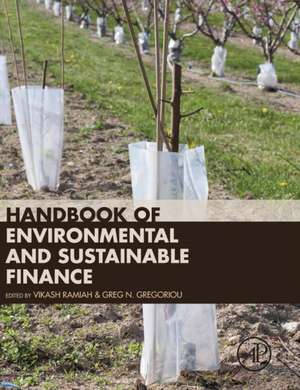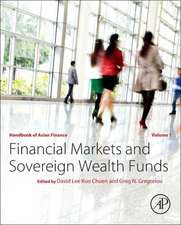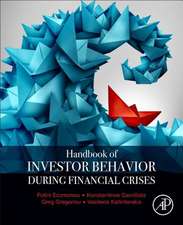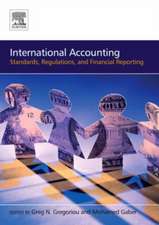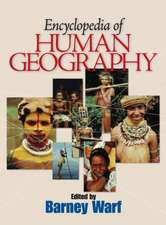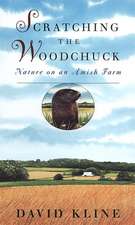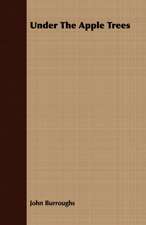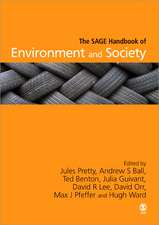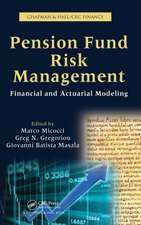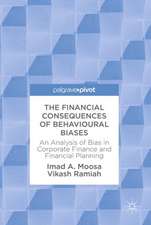Handbook of Environmental and Sustainable Finance
Editat de Vikash Ramiah, Greg N. Gregoriouen Limba Engleză Hardback – 4 noi 2015
- Introduces the latest developments in environmental economics, sustainable accounting work, and environmental/sustainable finance
- Explores the effects of environmental regulation on the economy and businesses
- Emphasizes research about the trade-environmental regulation nexus, relevant for economics and business students
Preț: 455.04 lei
Preț vechi: 576.82 lei
-21% Nou
Puncte Express: 683
Preț estimativ în valută:
87.10€ • 91.51$ • 73.20£
87.10€ • 91.51$ • 73.20£
Carte tipărită la comandă
Livrare economică 04-18 martie
Preluare comenzi: 021 569.72.76
Specificații
ISBN-13: 9780128036150
ISBN-10: 012803615X
Pagini: 510
Dimensiuni: 191 x 235 x 28 mm
Greutate: 1.2 kg
Editura: ELSEVIER SCIENCE
ISBN-10: 012803615X
Pagini: 510
Dimensiuni: 191 x 235 x 28 mm
Greutate: 1.2 kg
Editura: ELSEVIER SCIENCE
Public țintă
Upper-division undergraduates, graduate students, and professionals studying and working in environmental economics and corresponding fields in accounting, business, regulation, and financeCuprins
Section 1: Environmental Regulations Post the Kyoto Protocol on Climate Change
1. Climate Change and Kyoto Protocol: an Overview
2. Environmental Policies Post the Kyoto Protocol on Climate Change: Evidence from US and Japan
3. Efficiency of U.S. State EPA Emission Rate Goals for 2030: A Data Envelopment Analysis Approach
Section 2: Environmental Economics
4. Environmental Water Governance in the Murray-Darling Basin of Australia: The Movement from Regulation and Engineering to Economic-Based Instruments
5. Damages Evaluation, Periodic Floods, and Local Sea Level Rise: The Case of Venice, Italy
6. Corporate Social Responsibility and Macroeconomic Uncertainty
7. A Fool on Green Hills?
8. What Holds Back Eco-Innovations? A "Green Growth Diagnostics" Approach
9. Trade Openness and Co2 Emission: Evidence from a SIDS
10. Will TAFTA be Good or Bad for the Environment?
11. Feminism, Environmental Economics, and Accountability
Section 3: Environmental/Sustainable Finance
12. Does National Culture Affect Environment Practices?
13. The Economic and Financial Effects of Environmental Regulation
14. Environmental Challenges and Financial Market Opportunities
15. Environmental Investment Strategies
16. The Relationship between Screening Intensity and Performance of Socially Responsible Investment Funds
17. Using CO2 Emission Allowances to Equity Portfolios
18. The returns from Investing in Water Markets in Australia
19. Product Market Competition and Corporate Environmental Performance
Section 4: Funding and Accounting Systems
20. The Costs and Benefits of Cost-Benefit Analysis as Applied to Environmental Regulation
21. The Crowdfunding of Renewable Energy Projects
22. From Environmental Economics to Accounting System Design: Weighing Up the Costs and Benefits of Sustainability
1. Climate Change and Kyoto Protocol: an Overview
2. Environmental Policies Post the Kyoto Protocol on Climate Change: Evidence from US and Japan
3. Efficiency of U.S. State EPA Emission Rate Goals for 2030: A Data Envelopment Analysis Approach
Section 2: Environmental Economics
4. Environmental Water Governance in the Murray-Darling Basin of Australia: The Movement from Regulation and Engineering to Economic-Based Instruments
5. Damages Evaluation, Periodic Floods, and Local Sea Level Rise: The Case of Venice, Italy
6. Corporate Social Responsibility and Macroeconomic Uncertainty
7. A Fool on Green Hills?
8. What Holds Back Eco-Innovations? A "Green Growth Diagnostics" Approach
9. Trade Openness and Co2 Emission: Evidence from a SIDS
10. Will TAFTA be Good or Bad for the Environment?
11. Feminism, Environmental Economics, and Accountability
Section 3: Environmental/Sustainable Finance
12. Does National Culture Affect Environment Practices?
13. The Economic and Financial Effects of Environmental Regulation
14. Environmental Challenges and Financial Market Opportunities
15. Environmental Investment Strategies
16. The Relationship between Screening Intensity and Performance of Socially Responsible Investment Funds
17. Using CO2 Emission Allowances to Equity Portfolios
18. The returns from Investing in Water Markets in Australia
19. Product Market Competition and Corporate Environmental Performance
Section 4: Funding and Accounting Systems
20. The Costs and Benefits of Cost-Benefit Analysis as Applied to Environmental Regulation
21. The Crowdfunding of Renewable Energy Projects
22. From Environmental Economics to Accounting System Design: Weighing Up the Costs and Benefits of Sustainability
Recenzii
"Believably the first collection after the Paris climate summit, this handbook fills a gap of reference materials by combining sustainability and finance issues. It examines some of the most pressing challenges in green investment in the Kyoto era, while provides interesting insights into possibly new paradigms for post-Kyoto days. I highly recommend this resource guide to intellectuals who work to make sustainable finance truly sustainable." --Alastair Marke, FRSA
"This is a timely publication that addresses climate change, water rights and innovative ways to manage and sustain our environment. These issues are covered from a financial and economic perspective, addressing regulation, culture and geography ranging from crowd funding to the role that women play in protecting our global resources." --Christine Helliar, UniSA Business School
"The breadth of coverage in the handbook underscores the multi-faceted - and heartening - development of this field, in both research and application. From Venice to the Australian Outback, this book locates examples of broader and balanced financial approaches to the valuation and preservation of scarce resources. An essential resource for the field." --Marie Wilson, University of South Australia Business School
"This is a timely publication that addresses climate change, water rights and innovative ways to manage and sustain our environment. These issues are covered from a financial and economic perspective, addressing regulation, culture and geography ranging from crowd funding to the role that women play in protecting our global resources." --Christine Helliar, UniSA Business School
"The breadth of coverage in the handbook underscores the multi-faceted - and heartening - development of this field, in both research and application. From Venice to the Australian Outback, this book locates examples of broader and balanced financial approaches to the valuation and preservation of scarce resources. An essential resource for the field." --Marie Wilson, University of South Australia Business School
